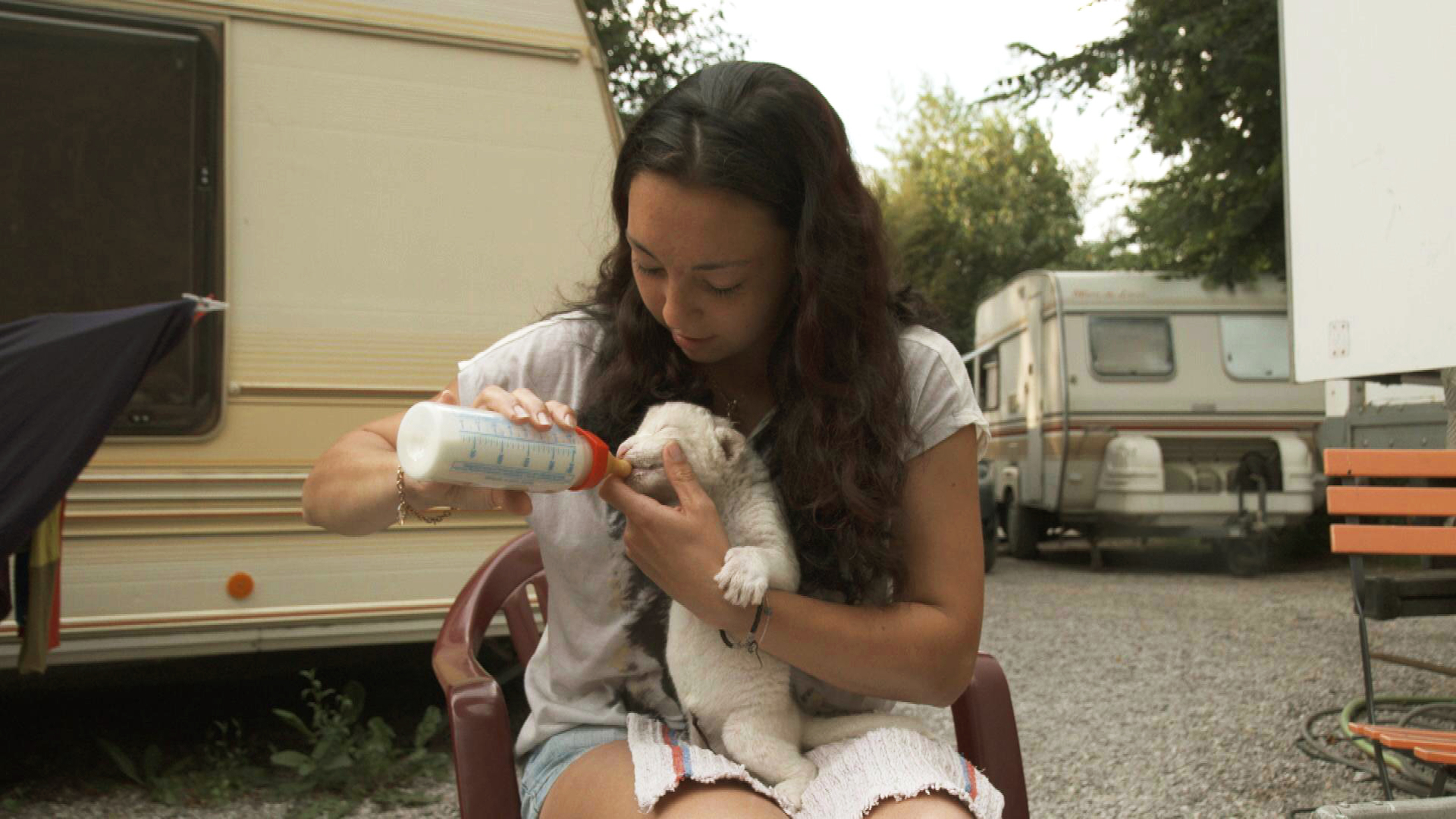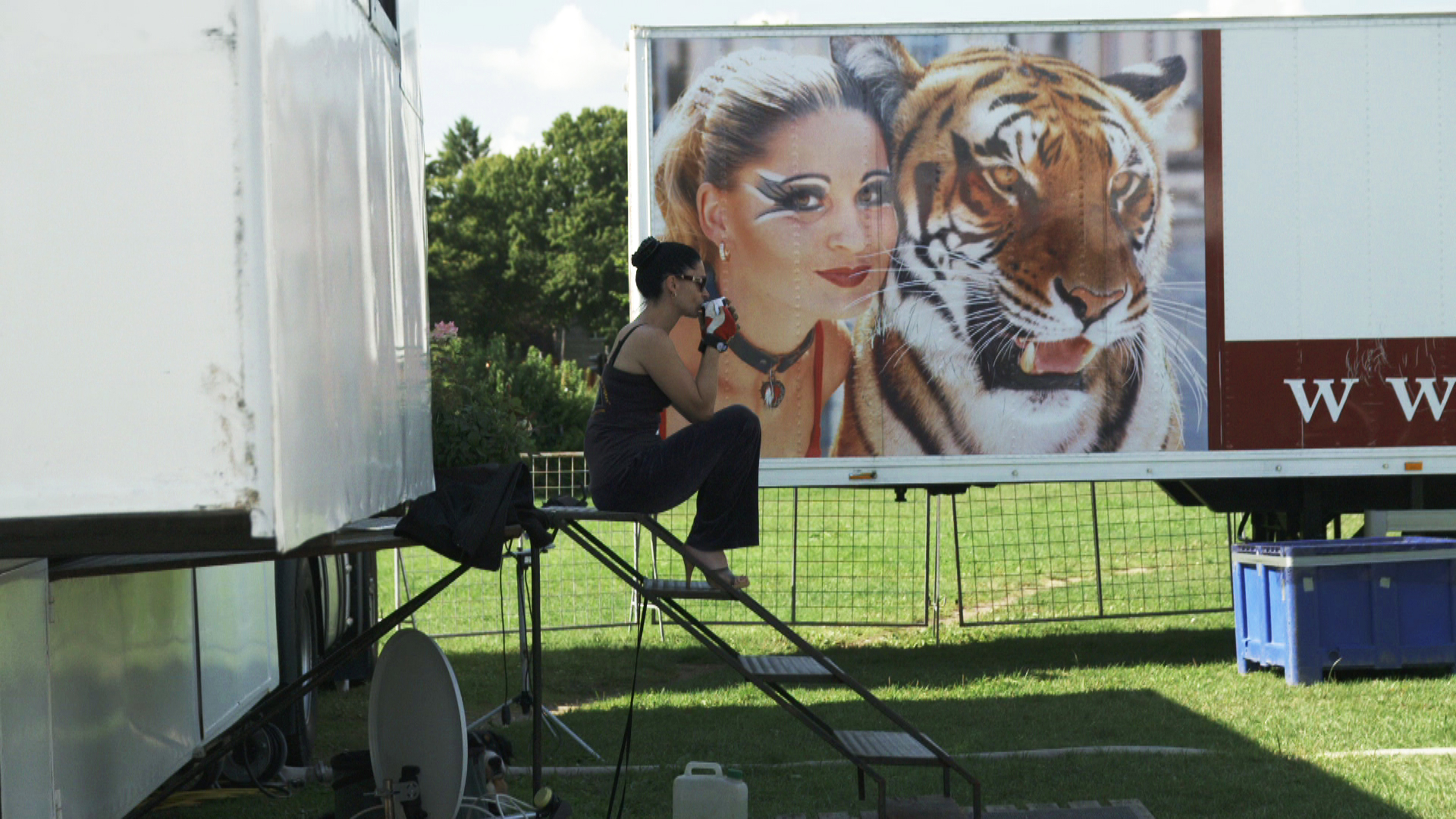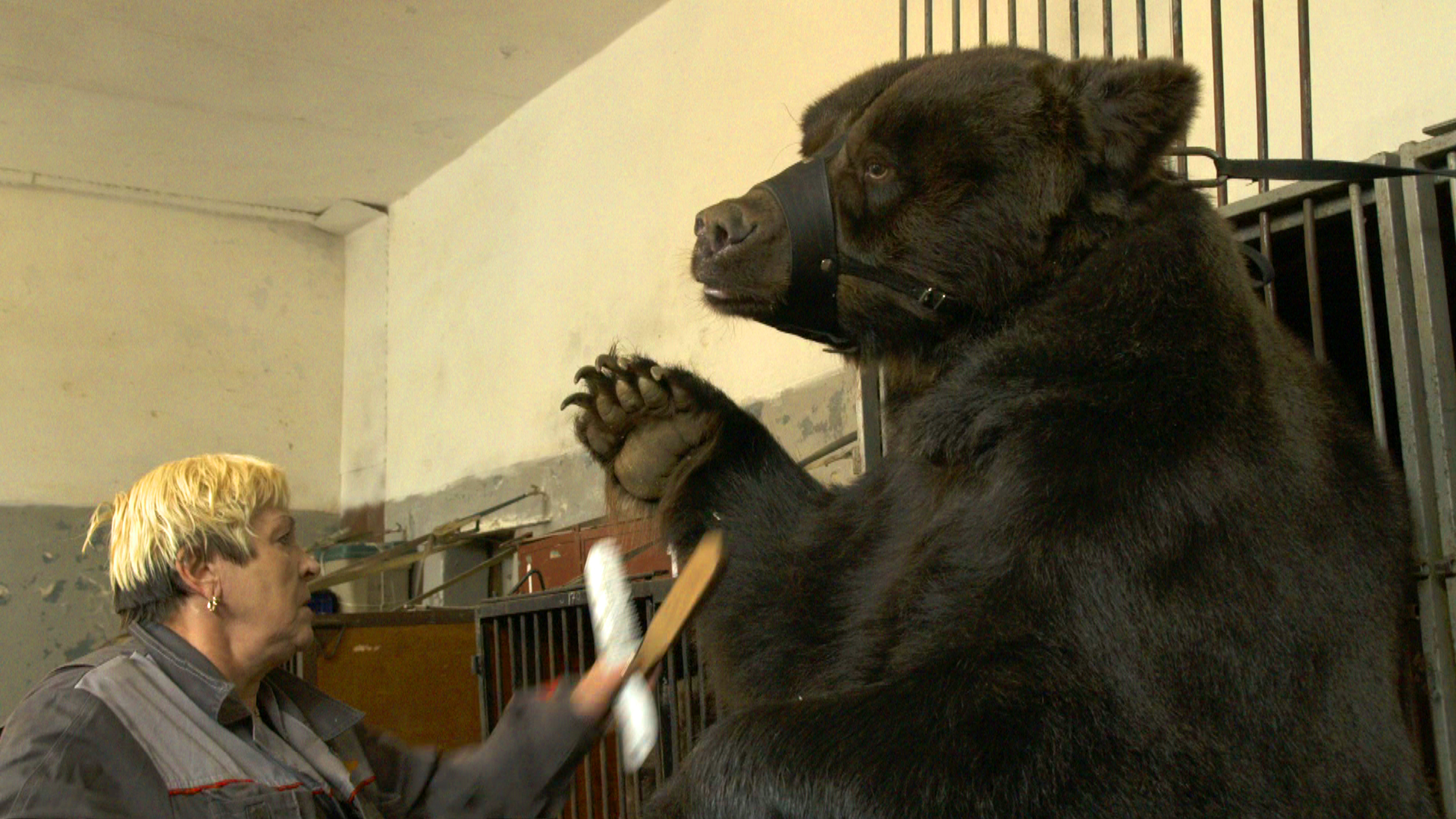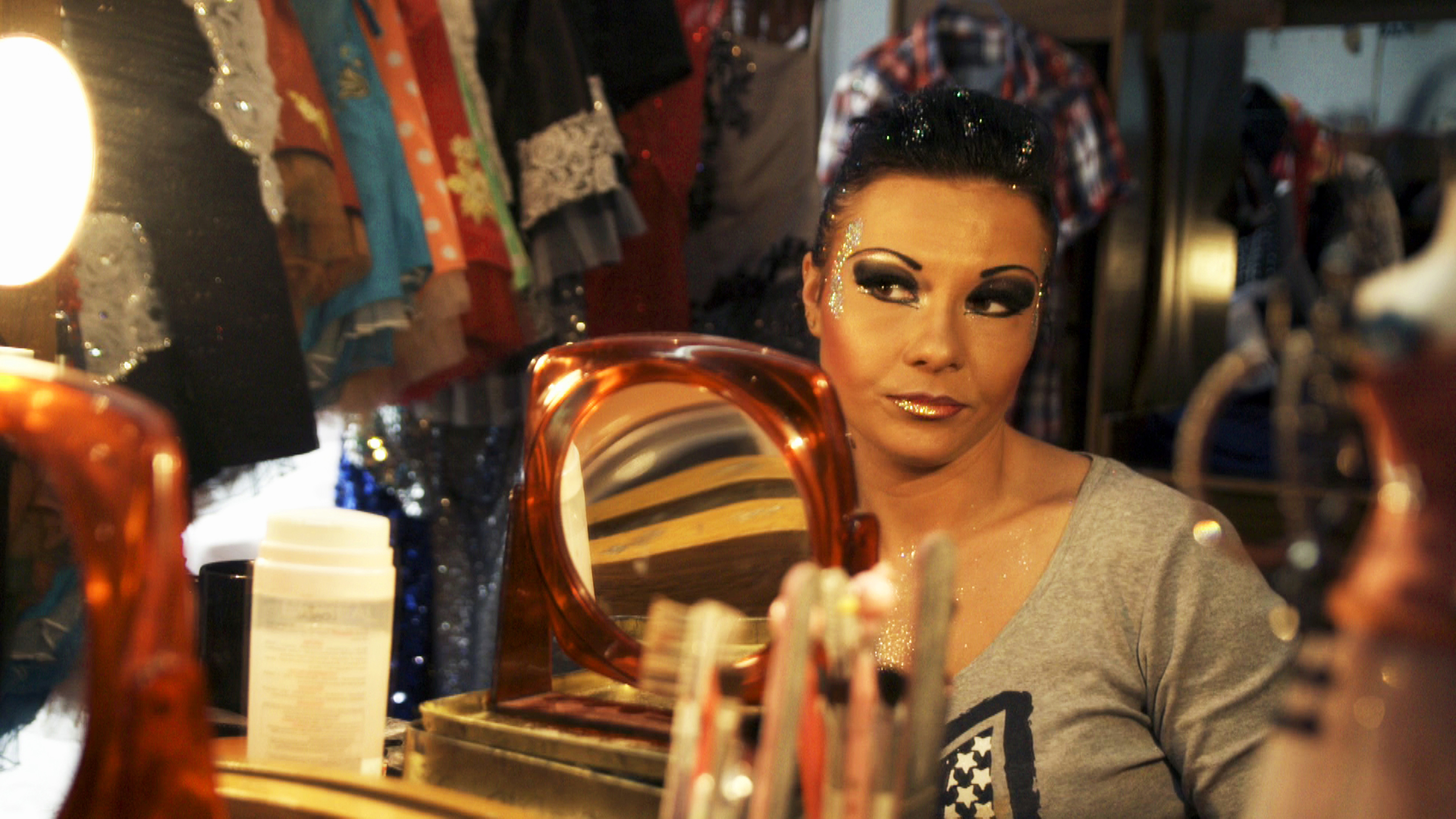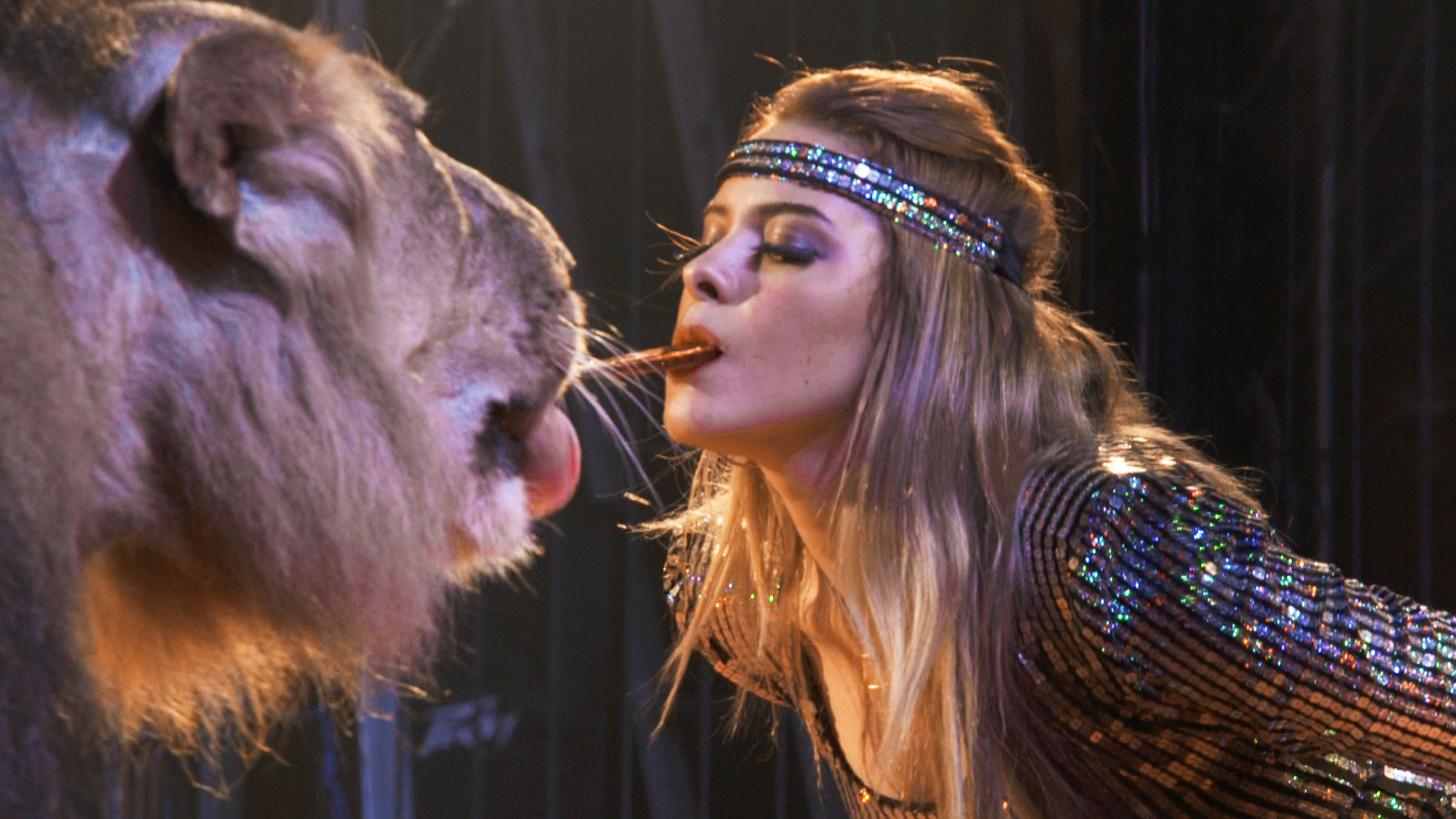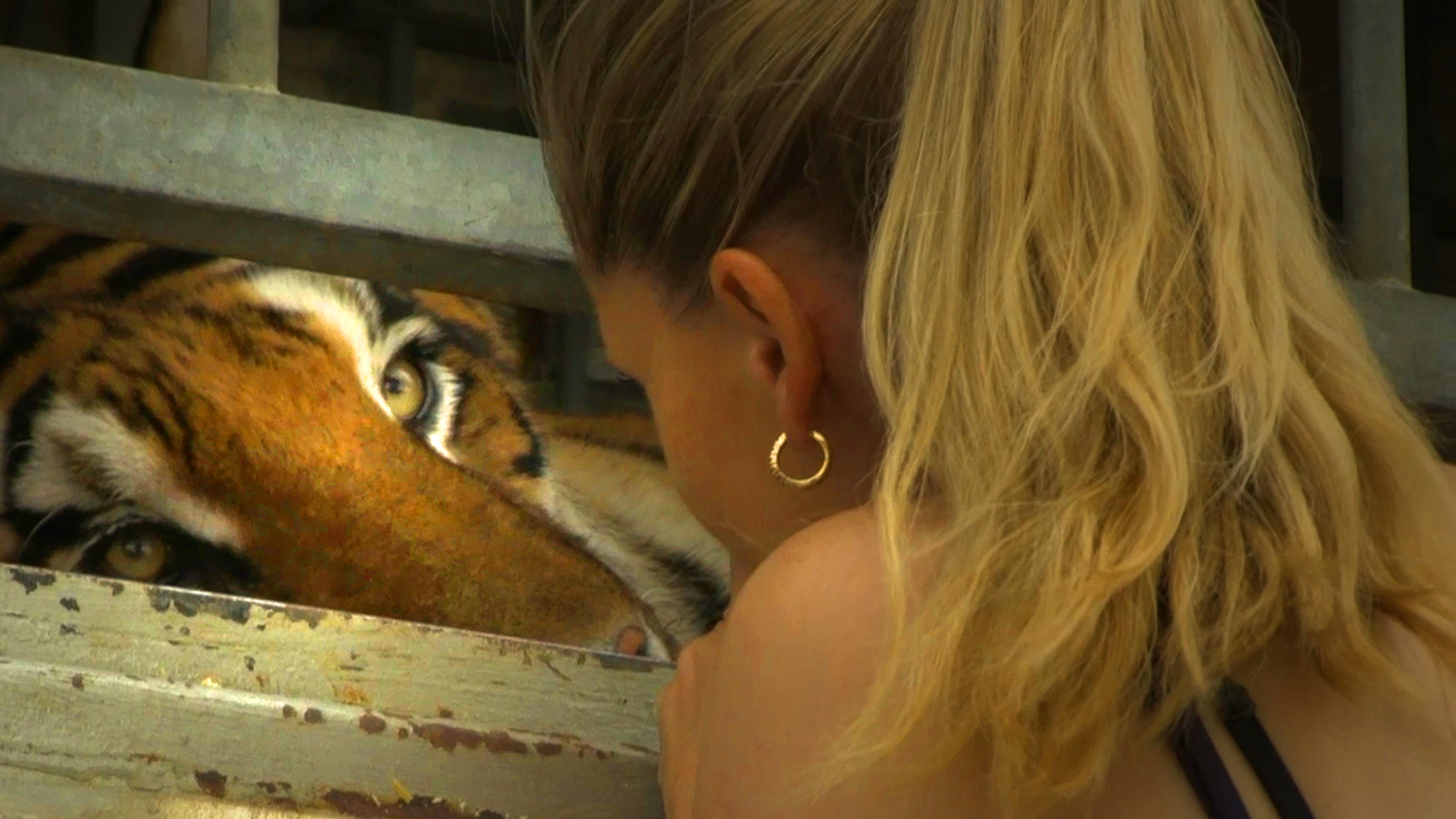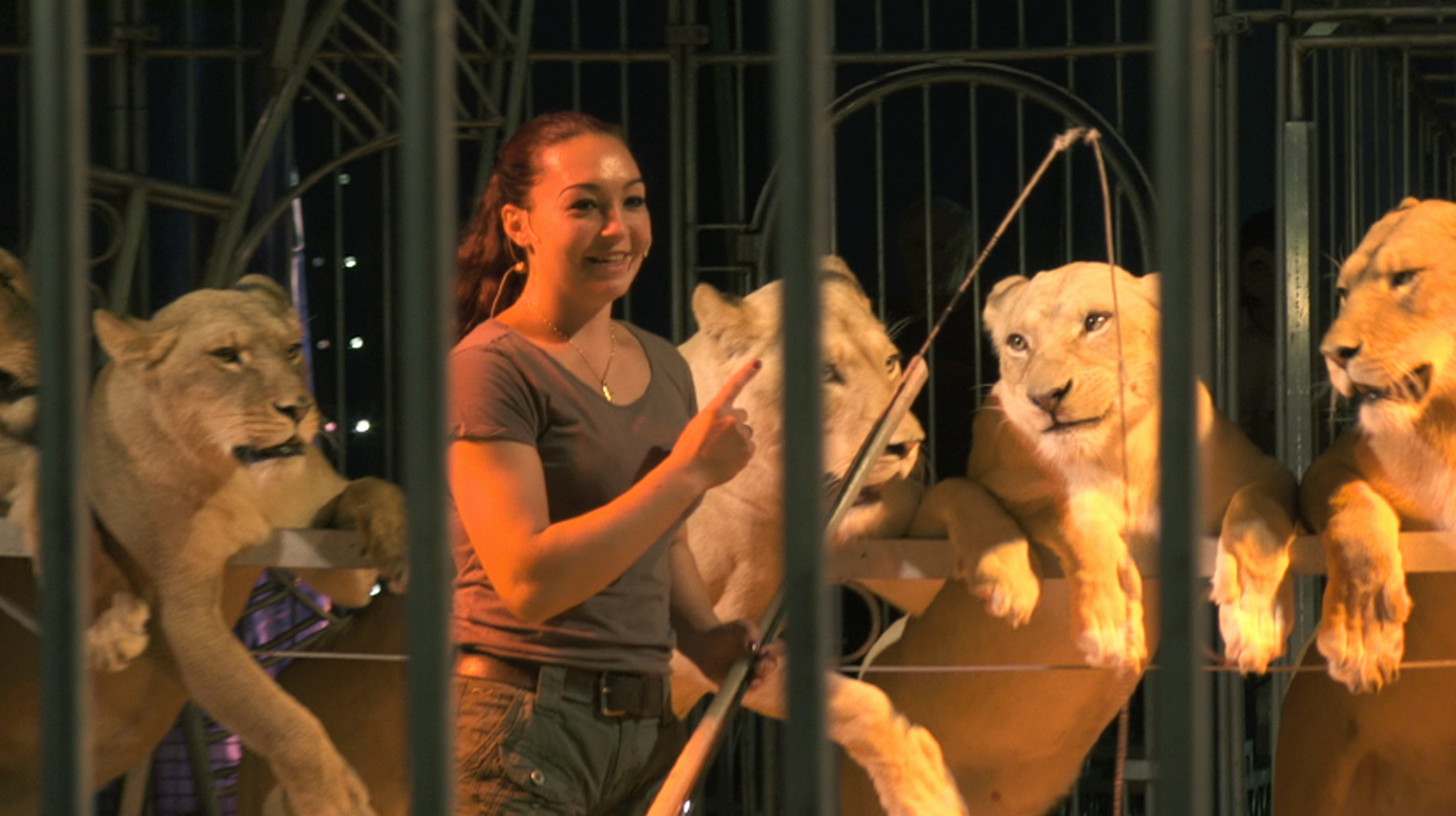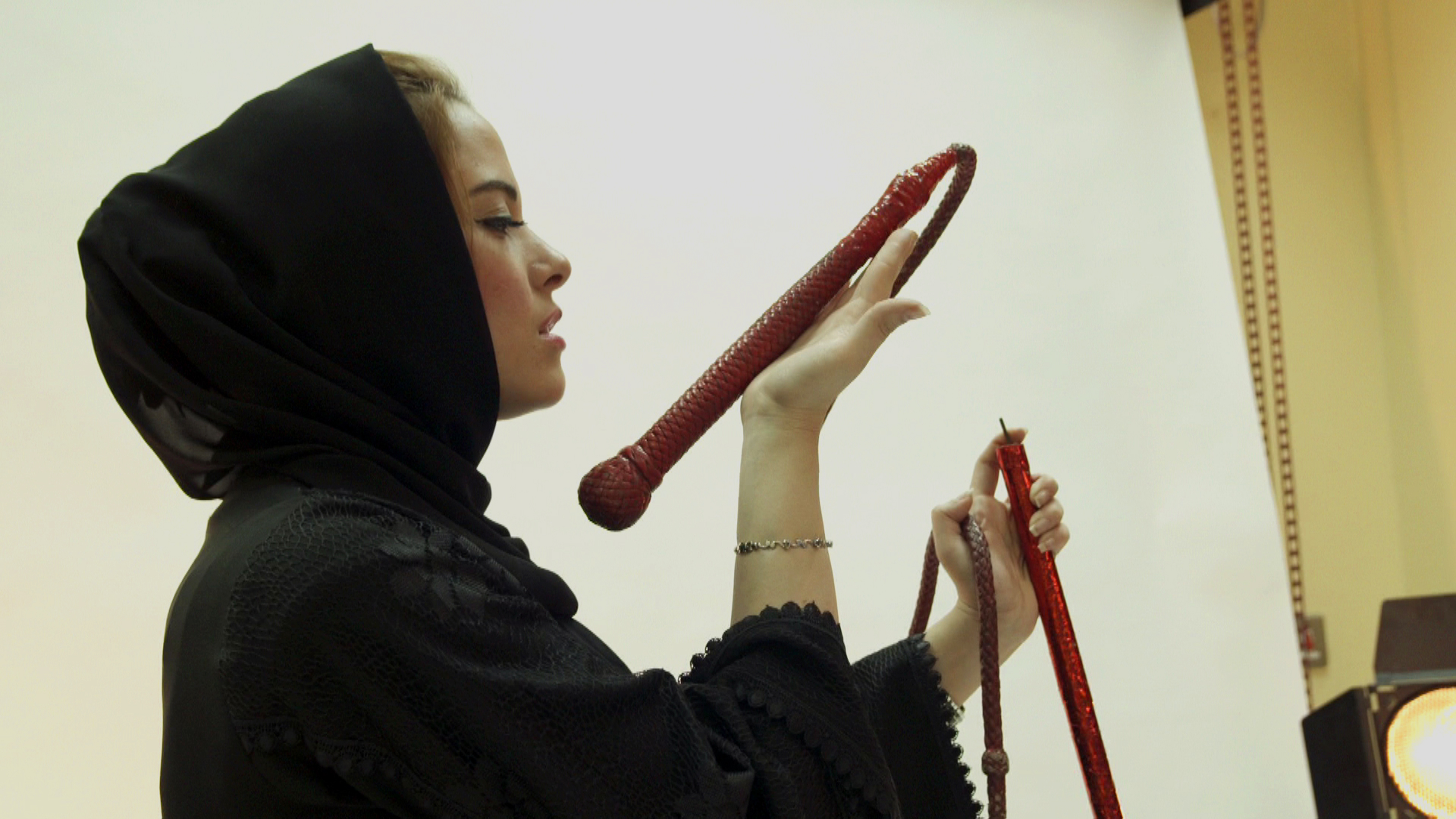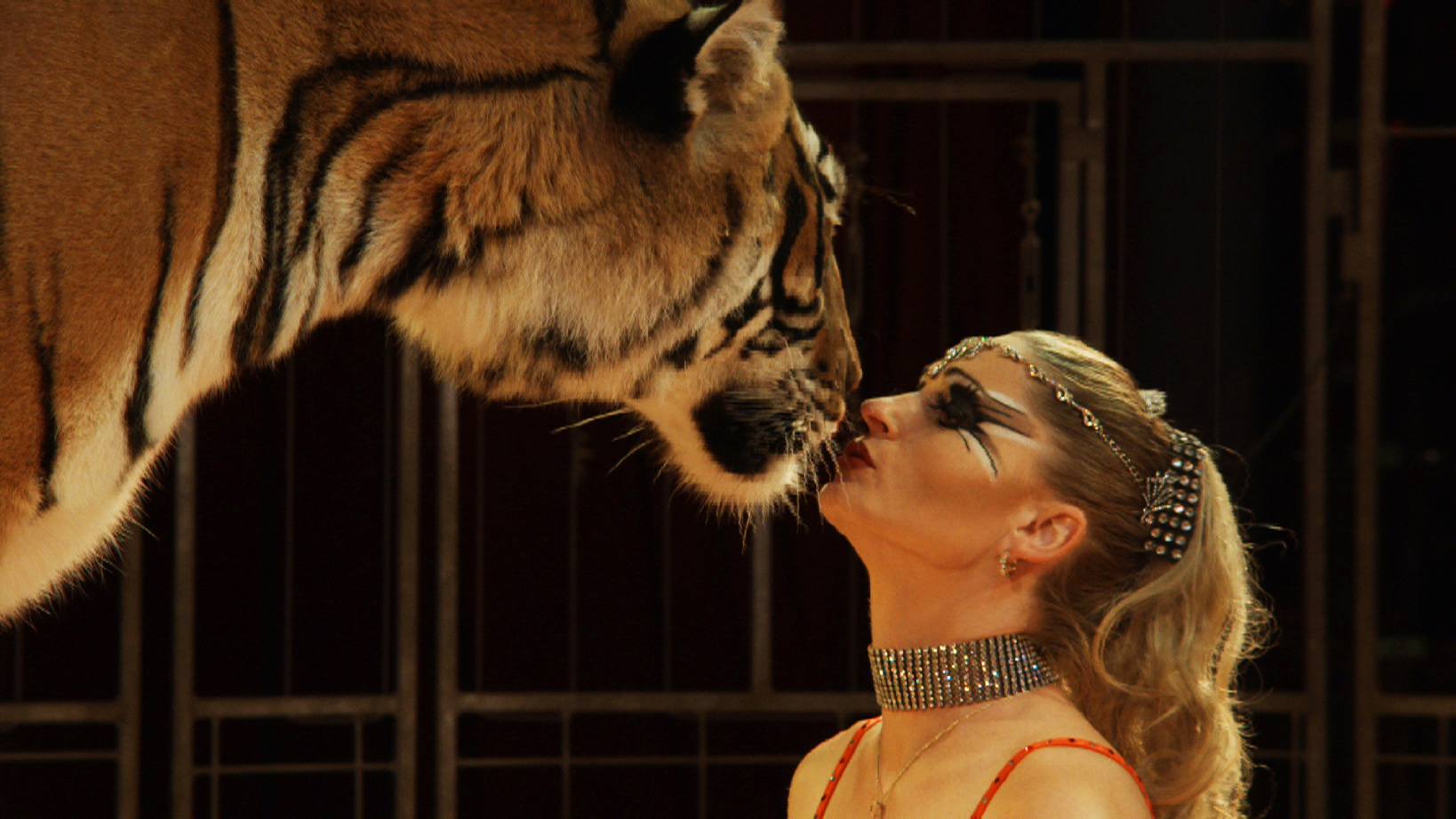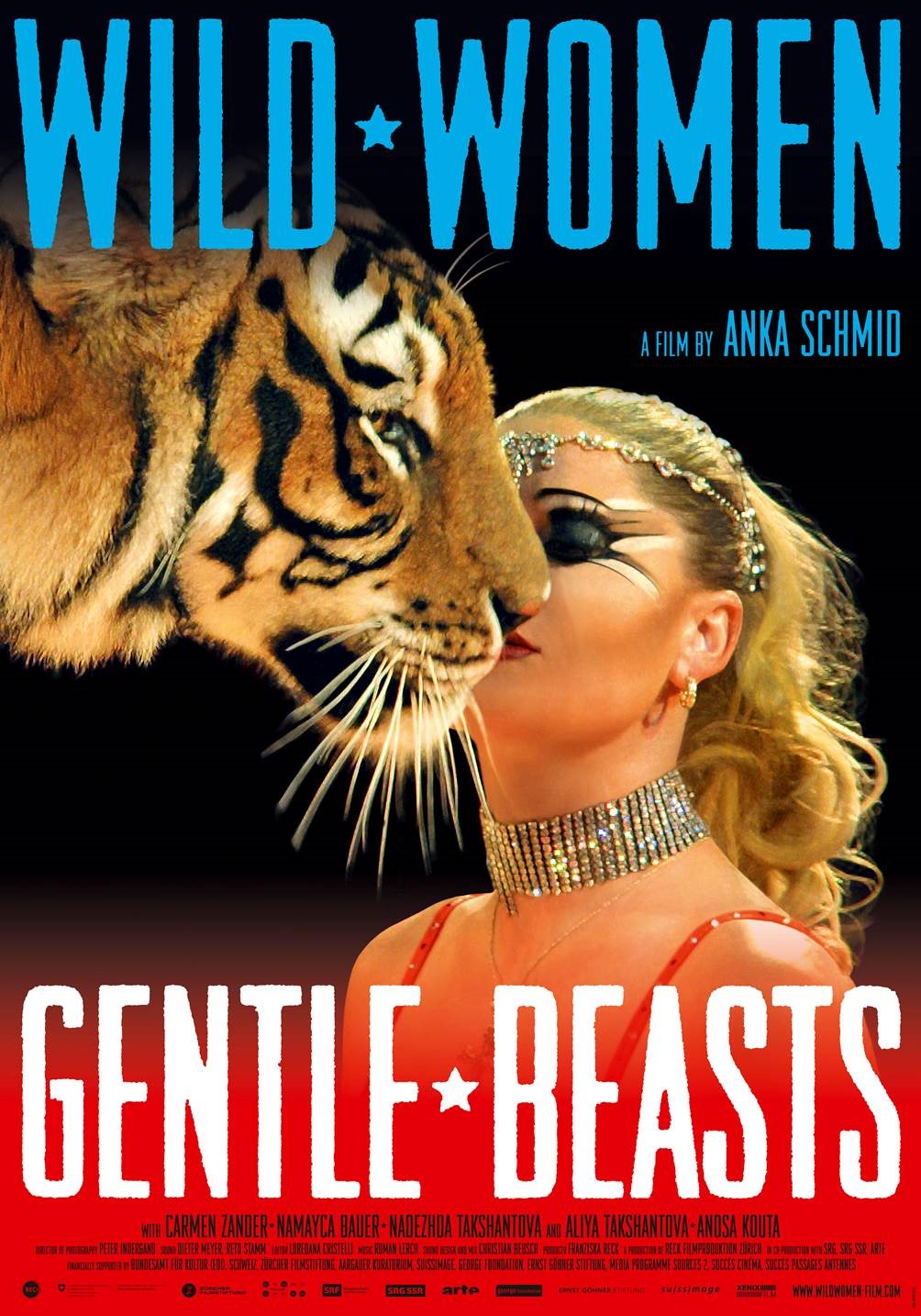
Animal tamers from various continents shine in the spotlight and struggle for their existence behind the scenes.
Synopsis
Animal tamers from various continents shine in the spotlight and struggle for their existence behind the scenes. Namayca, Carmen, Nadezhda, Aliya, and Anosa are five women from four different countries, but all are charismatic animal tamers. They work in the circus and train tigers, lions, and bears. Between toiling and smiling, the female circus artists disclose their passion for their “wild” animals and extraordinary profession. Switching between dominatrix and cuddly kitten in the arena, they play with the contrast between docile woman and wild beast. In doing so, they always overcome their own limitations and risk death in a dangerous show full of total dedication, absolute presence, and physical perfection. Their ultra-close relationship with their animals is sensual – and immensely grueling.
Director Anka Schmid (Against all Odds) illuminates the harsh reality behind the sparkling images and offers a respectful view into the exotic life of these artistic performers. The women speak candidly about their wishes and desires – about their lives between freedom and extreme dependence, between admiration and exclusion. Always in conflict between feminine gentleness and commanding toughness, they struggle for their existence both as women and as tamers – a profession that may soon be outlawed. A film of indomitable power that puts to the test images of both beauty and beast.
Festival
- Days of Cinema, Palestine, 15. -21.10. 2016
- Batumi International Art House Film Festival, 18. – 25.9. 2016
- Internationales Filmfestival Innsbruck, 24. – 29.5. 2016
- Thessaloniki Documentary Festival, 11. – 20.3. 2016
- Cairo Int. Women’s Film Festival, 27.2 – 3.3. 2016
- Solothurner Filmtage, 22. & 25.1. 2016
- Artdocfest Moscow, 12.12. 2015
- Dharamsala Int. Film Festival, 7.11. 2015
- Biberacher Filmfestspiele 5.11. 2015
- Int. Hofer Filmtage, 22. und 24.10. 2015
- Festival del Film Locarno, Panorama Suisse, 10.8.2015, 11h FEVI
- Festival Visions du Réel, Section Hélvetique, 19.4. und 20.4. 2015
Cast and More
Namayca Bauer (19) | France
Namayca Bauer is a Jill-of-all-trades hailing from seven generations in the circus who works with lions, tigers, horses, goats, pigs, and dogs. Her two younger sisters are still in school, while Namayca, her father, and her boyfriend Yoan take care of forty big cats and many smaller animals. The young performer is known for her appearance on a French TV talent show and won second prize in the prominent “New Generation Festival” in Monte Carlo. During filming, Namayca celebrates her 19th birthday. In the film she is shown going about her daily work and training with young and old animals where they previously lived, in an amusement park on the French coast (Bercks-sur-Mer). She has found new love with Yoan, her boyfriend and constant companion. But since he is not from a circus family, conflicts arise with the parents. Since the summer of 2014, the family has had its own animal park and circus show in Saint-Léger, near Paris.
„On the day of my birth the baby lion Sultan was also born. On walks, he lay beside me in the stroller.“
„Circus people don’t like mingling with others and since I was never really together with other children, I went directly from child to adult. I never had any puberty problems.“
Carmen Zander (40) | Germany
The attractive German Tiger Queen Carmen Zander entered the circus following her background in competitive sports. Not being from a circus family, she struggles on her own with the difficulties of everyday circus life, which she skilfully masters with a sexy and humorous touch. She has bottle-fed and trained her five magnificent tigers herself. In Germany, an ongoing campaign to ban predatory animals in circuses jeopardises her career. Carmen is fighting to save her livelihood, in the hopes that she can continue to work with tigers and set up her own tiger park. The film accompanies her during the strenuous circus tour, with long rides in the lorry she drives herself, with frequent assembly and dismantling of the enclosure, her sorrows and joys with her tigers, her daily struggle as a woman in a man’s world and her spectacular appearances performing in the ring. She is accompanied in the winter by her assistant Lars Jünemann, and in the summer by her brother Kai Breuer.
„I think it’s a pity that the men assume a woman in private is like in the show. Men are startled by a dominant woman. Although I am that too.“
„When an animal is sick, I suffer unbelievably and am totally helpless. But I still have to take care of everything, because the tigers want and need lots of care every day.“
Nadezhda Takshantova (60) | Russia
Nadezhda Takshantova, who hails from Russia, has fought her way into the circus, after her beginnings as a animal keeper in the Soviet Union. She has now been working as a bear tamer for almost thirty years. She is the only woman in Russia to perform with her own bears, the largest of which is 2.7 metres tall and weighs 580 kilos. She holds the prestigious state-recognised title of “Meritorious Artist of the USSR” and is considered a registered animal tamer in Russia and the former Soviet republics. Nadezhda is married to Tagir Takshantov, a circus clown, and has a 27-year-old daughter.
“Loving animals is not enough. Seeing is not enough, you have to feel it. That needs experience. Because after all it took me a while to become an animal tamer.” „There were times when she was afraid of bears. She was so scared of big bears. I forced her, really forced her to overcome her fear.“
Aliya Takshantova (27) | Russia
Aliya Takshantova has inherited and learned her mother’s craft. She also owns and trains her own female bear. With her own natural and gentle manner, she has developed a distinct leadership style from that of her mother. Due to the uncertain future of the Russian circus, Aliya is training as a director and choreographer in show business. The film documents the Takshantov family’s arrival at their new circus station in Perm: a state circus featuring a fixed building with rings, stables, many employees and performers. We see them setting up in a new location, caring for the animals, and rehearsing for the premiere. In this stressful phase, conflicts and discussions continually arise among family members in the ring. Her mother Nadezhda wants to gradually withdraw from the limelight, but at the same time she is under great financial pressure and knows that her daughter does not yet have enough experience to take on sole responsibility for all her mother’s animals.
„Human can be callous, bad and aggressive. They kill and injure. But animals are quite divine, supernatural, sacred. They would never hurt anyone deliberately.“
“The bear I work with now, is like a sister to me. She can freak out, be in a bad mood, just like me. With a sister you can argue and fight, and afterwards all is back to normal.”
Anosa Kouta (24) | Egypt and Qatar
Anosa Kouta, the confident blonde Egyptian Lion Princess, is a well-known star in the Arab world and also works as a photo model and stuntwoman alongside her circus performances. Her revealing performances stand in contrast to the current political movement in Egypt. It is unclear whether Anosa can continue living and working as she has done. She has firm roots in the family business: her late grandmother was the first female lion tamer in the Arab world, and she is still known and respected today. Two other family members also carry on the family art form: her father works at the National Circus in Cairo, and her brother has been touring the former Soviet Union for years with eight male lions. Anosa herself goes on tour throughout Egypt and other Arab states. The filming took place during a time of great unrest that shook her homeland. Amidst the chaos, Egyptians hardly attended the circus, so Anosa went on tour with the “Monte Carlo” circus across Arab countries outside Egypt. We filmed her during her stay in Qatar and during Eid al-Adha, the Feast of the Sacrifice. She is accompanied by two Egyptian assistants, Shaban and Tarek, whom she has known since childhood. She keeps in touch with her family thousands of kilometres away through phone and Skype.
“With lions it’s like people. There are big lions and little lions, fat and thin, funny and boring. Artistes, and stupid ones. There are good-hearted or cunning ones. These frighten me the most. Lions are like people.”
„The work makes me happy, although it’s tiring. It helps me to get over loneliness and sadness. As soon as I enter the cage, I forget that I’m Anosa. I’m just the lion tamer.“
Director’s Note
ENTRÉE – HOW THE FILM CAME ABOUT
The starting point of my documentary about women animal tamers came from my personal fascination toward these courageous women with extraordinary careers. Even as a young girl, I was attracted by one such tamer from “Salto Mortale”, a 1960s television series. I wanted to become a tiger tamer, just like she was. Now, as a 50-year-old filmmaker, I try to explore the realities of these daring women and what it actually takes to carry out this dangerous profession. I want to make visible what is hidden behind the image of the glittering sexy woman, and what her professional life looks like away from the limelight. What kind of relationship do they have with these dangerous animals, and how do they experience their situation as women? The longer I dealt with the reality of this professional world, the more complex the film project became. Women have performed as animal tamers since the beginning of circuses, yet they have always been an exceptional phenomenon. There is an apparent contrast between docile woman and wild beast, which generates a lot of attention: “La belle et la bête”, the beautiful woman with the power of gentleness – what an imposing image. Today there are only a handful of women working as big animal trainers, and they are becoming an ever-rarer species. As such, it was something of an adventure to find women working in the field and track them down in various countries. Finally I decided to follow Namayca Bauer, Carmen Zander, Anosa Kouta, and Nadezhda Takshantova and her daughter Aliya. They won me over with their professionalism, their artistic nature, and their sixth sense for their animals. At the same time I could see how differently they approach the art of animal taming and how unique their respective everyday lives are in the various countries.
THE TAMERS
In spite of all the differences among the protagonists such as age, family situation and performance opportunities, they all have one clear commonality: they all love their job and their animals more than anything. They know their gentle beasts very well, spending many hours per day with them, both in the ring and regularly caring for them, feeding them, and training them. And they know that these are, after all, dangerous predators. This is no reason for them to be afraid of their animals – but it requires absolute attention. Anything can happen in just one second of distraction. This is what I witnessed at the beginning of my research trip to Russia, when an accident almost occurred due to a moment of carelessness. This incident just served to sharpen my perception of the animals. The more time I spent with the animal tamers, the more I respected these women for their courage. Struggle is part and parcel of their daily business, whether in working with the animals, in providing them sufficient meat, in competition amongst the performers, or in facing the attacks upon them by radical animal rights activists.
THE CULTURE OF DOMESTICATION
The animal taming profession is threatened with extinction. Soon there will be no more lions and tigers shown in circuses. In numerous countries around the world – across Scandinavia and in Belgium, Greece, Austria, Israel, Mexico, Peru, and Singapore, there is already a ban on predatory animals performing in circuses. In Germany and other European countries such as England, a law is being drafted. The possibilities for performing are decreasing every year for these female tamers and their male counterparts, and the bleaker their prospects, the bigger their worries. What will become of their beloved animals? I see these animal tamers as representing another world – a mysterious, magical world. The first people to capture and train wild predatory animals were the priests and priestesses of ancient Egypt. They directly faced down these overwhelmingly powerful animals, symbolically vanquishing death. In contrast to gladiators who killed the animals to delight spectators, they conquer the threat without violence. Today the art of up-close-and-personal animal taming is being eliminated from the circus whilst films featuring battles against dragons or robots conquer the big screen. These forms of taming find huge success because we as humans have an archaic desire for challenges that involve overwhelming forces; an image of struggle that often recurs in our dreams when we are chased by wild animals.
PRESENCE OF WOMEN
Performances featuring humans and predatory animals come down to a game between dominance and submission; the hunter and the hunted. If, however, an attractive female tamer is in the ring, another component – that of eroticism – is added into the mix, and the game becomes more complex. This element can be seen in my film in the comparison between the Egyptian tamer and her brother: he acts aggressively whilst performing, whereas Anosa’s dominance comes across as affectionate. But in the crack of a whip it changes instantaneously into clear superiority. All my protagonists are skilled in staging this feminine charade, be it due to their costumes, their performance or the type of show they are presenting. The young Frenchwoman Namayca also creates another image: that of the paradisiacal world when human and animal lived in harmony. During her act she runs like a gazelle amongst her pride of lions, and jumps with them over obstacles. These moments are magical, and at the same time extremely dangerous, because if the young woman were to fall down, the animals would immediately pounce upon her and rip her to shreds.
CHALLENGES OF FILMING
Filming with such dangerous animals requires taking various precautions. A film crew brings an increased risk to the tamer, as the animals react to us, resulting in unrest amongst the group. It was particularly challenging with Carmen’s camera-shy tigress Imani, who responded immediately to the cameraman, the man with the mysterious “third eye” and its creeping movement. Even the sound man produced a special challenge, because the animals constantly wanted to play with what to them looked like a fur ball – his microphone in a fluffy protective covering. In this respect, we had to use a variety of tricks to obtain good recordings of the animals’ sounds and their breathing. The unusual filming situation resulted in an elaborately thought out reworking of the soundtrack including sound effects, and demanded a special musical concept that contrasts with the usual circus music. I was aware from the outset that sound would be of great importance in the design of the film, in order for the sound to correspond to the visual impact of these beautiful women and their attractive animals. FINALE As a child, watching a female animal tamer perform was a formative experience. The magic of this art form came through during filming and was by no means lost behind the curtains. That enchantment is still there, but it has changed through knowing how hard the work really is, the struggles inherent in working within the circus world, and how multifaceted the women’s roles are. Yet all this created for me a new magic: their absolute and unconditional devotion. In this way, these glittering tamers of beasts in the ring have shown –with their attention and their respect –how dependent we as humans are on the interaction with animals and nature.
Crew
Anka Schmid
Anka Schmid sees herself as a border-crosser between film and art and, in addition to narrative cinema and TV films, she also makes experimental films and video installations.
She has won various prizes and awards and has made numerous exhibitions. Her films have been shown at international festivals such as Locarno, Nyon, Berlinale, San Francisco or Sundance.Anka Schmid was born in Zurich in 1961.
She graduated from high school and in the turbulent 80’s she was active in a street theatre and a music band. 1984 – 1990 she studied in Berlin at the German Film and TV Academy, (Deutsche Film- und Fernsehakademie Berlin – DFFB).
In 1989 she spent a year in the USA, shooting the Hopi documentary TECHQUA IKACHI, LAND – MEIN LEBEN with the Hopi Indi¬an James Danaquymptewa and the artist Agnes Barmettler.She completed her studies at the DFFB with the feature film HINTER VERSCHLOSSENEN TÜREN (1991), which won numerous prizes.
After that, she worked as freelance cinematographer and director’s assistant in Germany, Switzerland, France, Argentina and the USA. In 1994, her son was born in Berlin and in 1998 she moved to Zurich with him. In Switzerland, in addition to her own creative work, she is a lecturer in film.
Portrait with detailed filmography please see the ankaschmid.ch
Reck Filmproduktion GmbH
RECK Filmproductions was founded in 2000 by Franziska Reck and focuses mainly on the development and production of documentary and experimental film – especially film essays – for cinema and television.Franziska Reck has been actively involved in the world of film for twenty years, promoting independent filmmaking in Switzerland. Beginning as a film distributor at the Filmcoopi in Zurich (1983—1990), she continued building up the distribution and promotion of Swiss films as director of the IGV/CID (1993-2000) and as freelance film producer herself (since 1990).Each film is one of a kind – unique, distinctive and unmistakable – and thus receives special, individual attention and treatment, for both production and distribution.
Crew
Written and Directed
Anka Schmid
Director of Photography
Peter Indergand
Sound Recording
Dieter Meyer Reto Stamm
Editing
Loredana Cristelli
Music
Roman Lerch
Sound Design and Mix
Christian Beusch
Producer
Franziska Reck
Additional Camera
Anka Schmid
Digital Workflow
Milivoj Ivkovic
Assistant Editing
Simon Gutknecht
Picture Design
Patrick Lindenmaier, Andromeda Film
Production Manager
Andrea Bürgi, Sandra Gysi, Clea Wanner
Ahmed Abdel Mohsen
Sound Editing
Guido Helbling, Alan Bagge
Foley
Julien Naudin, Laurent Chassaigne
Additional Composition
Thomi Christ, Sandra Stadler
Title Graphic
Sophia Murer
Translations
Mediamixtre
a Production of RECK Filmproduktion Zürich in Co-production with
Schweizer Radio und Fernsehen, Redaktion Urs Augstburger
SRG SSR, Redaktion Sven Wälti
ARTE, Redaktion Markus Nievelstein
with the Participation of
Zürcher Filmstiftung
Aargauer Kuratorium
Bundesamt für Kultur (EDI) Schweiz
Suissimage
george foundation
Ernst Göhner Stiftung
Media Programme Sources 2
Succès Cinema, Succès passage antennes
TECHNICHAL INFORMATION
Wild Women – Gentle Beasts
by Anka Schmid
Cinema Documentary Switzerland 2015, 96 min
Format: DCP 25fps / 1: 1.85
Sound: 5.1 Dolby Digital
Languages: German, French, Russian, Arab
Subtitles: English, German, French
Distribution Switzerland
Xenix Filmdistribution GmbH
Langstrasse 64
Postfach
8026 Zürich
Tel: +41 44 296 50 40
Film Production Switzerland
RECK Filmproduktion
Dienerstrasse 7
8004 Zürich
+41 (0)44 241 37 63
info@reckfilm.ch
www.reckfilm.ch
World Sales
Films Transit International Inc.
21, Place Epernay
Lorraine, Quebec J6Z 4K9 H3L 1A8 CA
+1 514 844 33 58
With Namayca Bauer, Carmen Zander, Nadezhda Takshantova, Aliya Takshantova and Anosa Kouta Dir Director Anka Schmid Camera Peter Indergand Sound Dieter Meyer, Reto Stamm Producer Franziska Reck edition Loredana Cristelli MusiC Roman Lerch Sound Design Christian Beusch A Produktion OF RECK Filmproduktion Zürich Additional Camera Anka Schmidi Digital Workflow Milivoj Ivkovic Assistng editing Simon Gutknecht Picture Design Patrick Lindenmaier, Andromeda Film Production manager Andrea Bürgi, Sandra Gysi, Clea Wanner Ahmed Abdel Mohsen Sound editing Guido Helbling, Alan Bagge Foley Julien Naudin, Laurent Chassaigne with partizipation of Zürcher Filmstiftung, Aargauer Kuratorium, Bundesamt für Kultur (EDI) Schweiz, Suissimage, george foundation, Ernst Göhner Stiftung, Media Programme Sources 2 and Succès CinemaSuccès passage antennes
